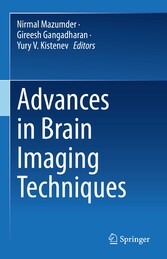The book reviews the recent developments in brain imaging and their technological advancements to understand molecular mechanisms associated with neurological disorders and basic behaviors in humans and rodents at the structural, molecular, and functional levels. It discusses the usefulness of advanced optical microscopy techniques, including optical coherence tomography (OCT), miniscope, multiphoton fluorescence (2PF & 3PF), adaptive optics, harmonic generation, and Raman microscopy for understanding pathomechanism of brain disorders and pathological and physiological changes associated with neurodegenerative diseases. Also, the book presents conventional imaging modalities, including Magnetic Resonance Imaging (MRI), for delineating underlying mechanisms and precise early diagnosis of neurological disorders. This book is a useful resource for neuroscientists and researchers working in biomedical engineering and optics.
Dr. Nirmal Mazumder is an Assistant Professor at the Department of Biophysics, Manipal School of Life Sciences, Manipal Academy of Higher Education (MAHE), Manipal, India. He obtained his Ph.D. in 2013 from National Yang Ming Chaio Tung University, Taipei, Taiwan. From 2013 to 2016, he worked as a postdoctoral fellow at the University of Virginia, the USA, and the Italian Institute of Technology, Genoa, Italy. He has been developing nonlinear optical microscopes, including two photon fluorescence, second harmonic generation, coherent anti-Stokes Raman scattering for biomedical applications. He has more than 10 years of teaching experience in biophysics, biophotonics, photonics, physics, and bioinformatics. He has published more than 50 research articles in the peer-reviewed international journals and is a member of several national and international scientific societies and organizations including, the Optical Society (OSA) (Senior member), SPIE-the International Society for Optical Engineering (Senior member), Society of Biological Chemists (I) (Life Member), Environmental Mutagen Society of India (Life Member).
Dr. Gireesh Gangadharan is an Assistant Professor in the Department of Cell and Molecular Biology at Manipal School of Life Sciences, Manipal Academy of Higher Education (MAHE), Manipal, Karnataka. He is the recipient of Ramalingaswami Fellowship, a prestigious fellowship from Department of Biotechnology, Government of India. Dr. Gangadharan received his Ph.D. in Neuroscience from Cochin University of Science and Technology (CUSAT), India. Subsequently, he did postdoctoral training at Korea Institute of Science and Technology (KIST) and Institute for Basic Science (IBS), South Korea, where he has made many critical findings on the neural mechanisms of behaviors at the integrated levels from genes to systems. His research interest is to understand the neural mechanism of animal behaviors such as exploration, anxiety, memory etc. He is trying to understand how different brain circuits are controlling diverse behaviors, with emphasis on the network interaction between different brain regions.
Dr. Yury Kistenev is a Professor at the Tomsk State University (TSU), Russia. He received his Ph.D. in optics in 1987; doctoral in physics and mathematics in 1997. He is the author of more than 150 research articles and has written two book chapters. His current research interests include laser molecular imaging, laser spectroscopy, and machine learning.









